Project Planning & Management: Phases, Feasibility, NPV, IRR, CPI
VerifiedAdded on 2023/06/15
|12
|2450
|446
Report
AI Summary
This report provides a comprehensive overview of project planning and management, covering essential aspects such as the project planning cycle, feasibility studies, Net Present Value (NPV), Internal Rate of Return (IRR), and the Critical Performance Index (CPI). It elaborates on the various phases and activities within the project planning cycle, emphasizing the importance of creating detailed plans for implementation and closure. The report also discusses the nature and contents of feasibility studies, highlighting their role in decision-making and risk assessment. Furthermore, it explains the meaning and application of NPV and IRR in evaluating project profitability, as well as the use of CPI as a tool for project monitoring and control, ensuring projects stay within budget and meet strategic goals. Access more solved assignments and resources on Desklib.
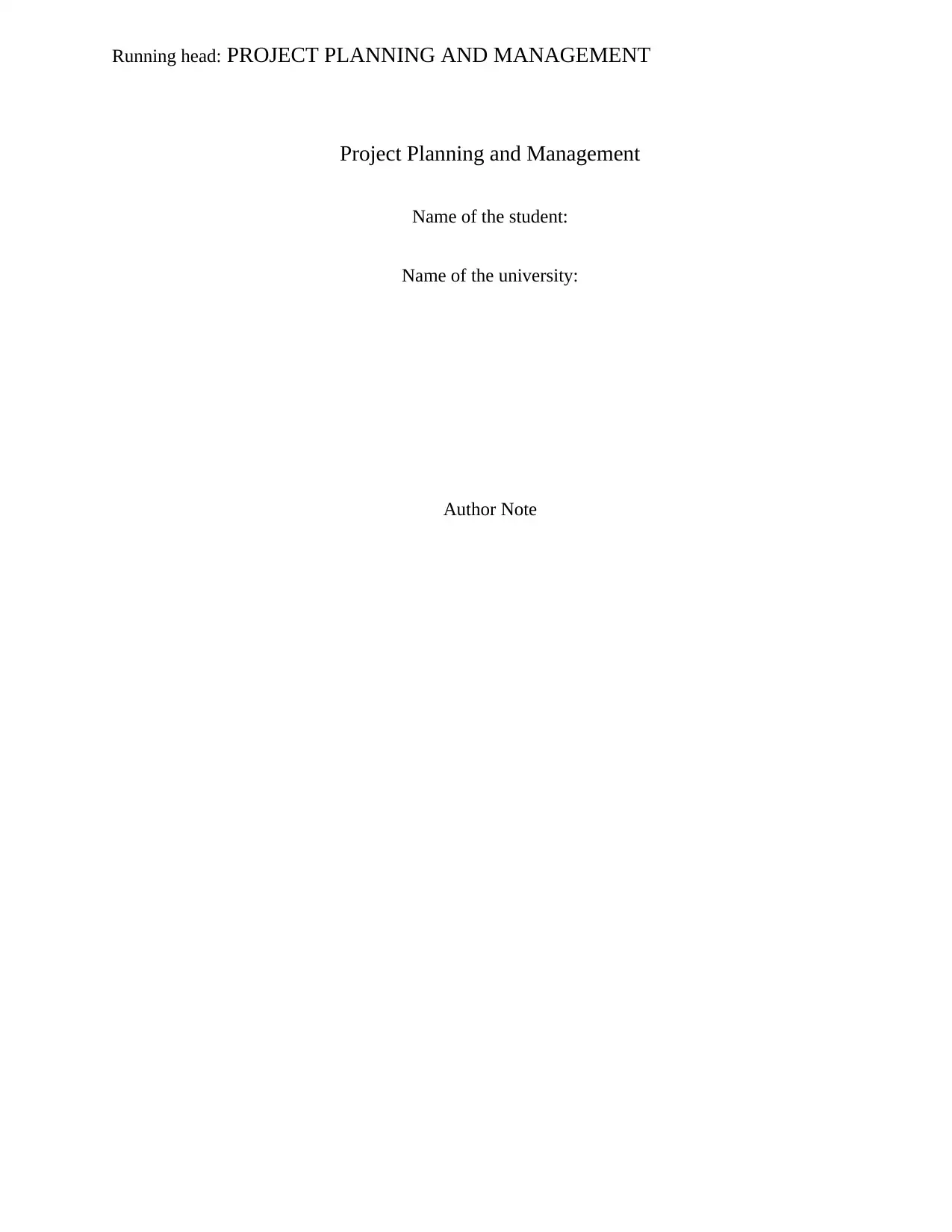
Running head: PROJECT PLANNING AND MANAGEMENT
Project Planning and Management
Name of the student:
Name of the university:
Author Note
Project Planning and Management
Name of the student:
Name of the university:
Author Note
Paraphrase This Document
Need a fresh take? Get an instant paraphrase of this document with our AI Paraphraser
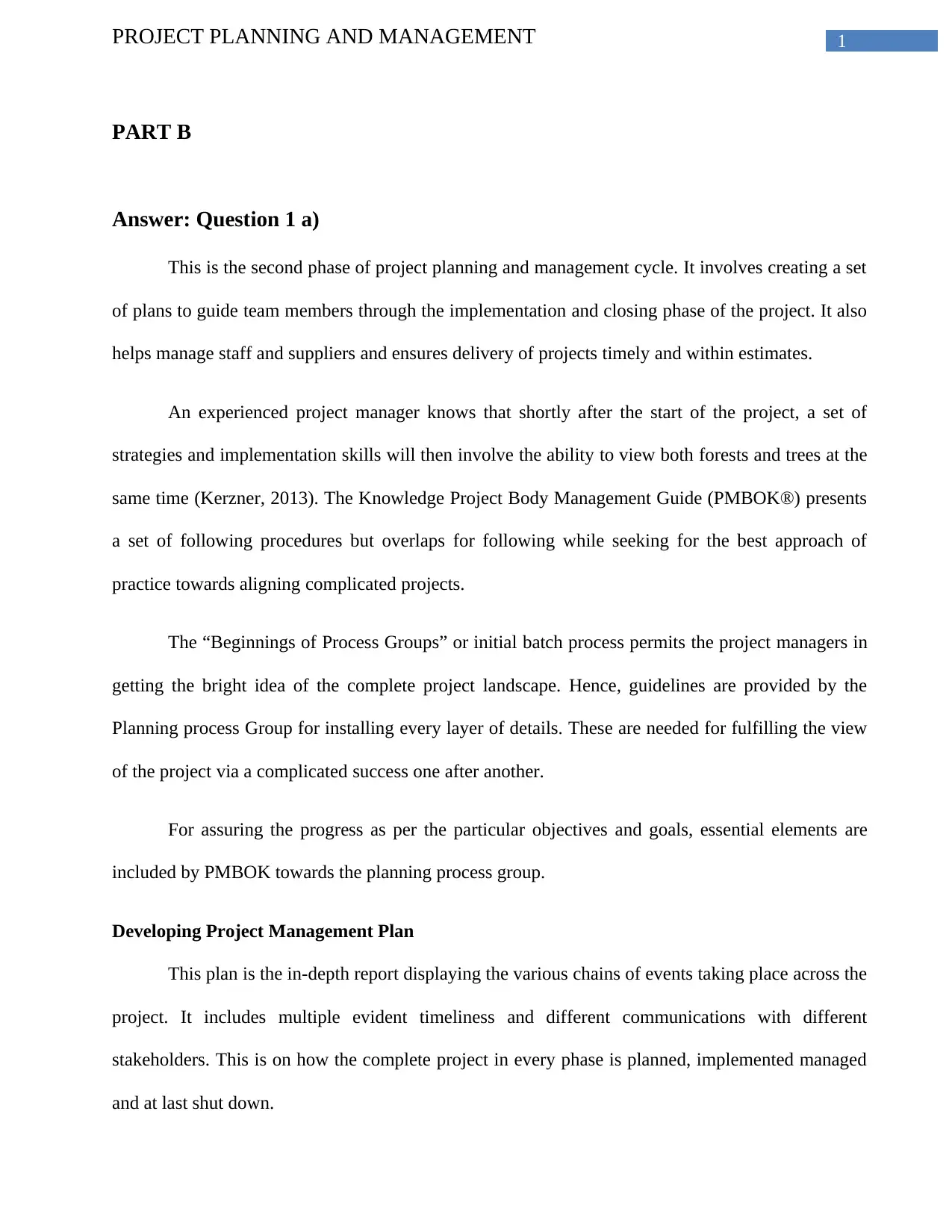
1PROJECT PLANNING AND MANAGEMENT
PART B
Answer: Question 1 a)
This is the second phase of project planning and management cycle. It involves creating a set
of plans to guide team members through the implementation and closing phase of the project. It also
helps manage staff and suppliers and ensures delivery of projects timely and within estimates.
An experienced project manager knows that shortly after the start of the project, a set of
strategies and implementation skills will then involve the ability to view both forests and trees at the
same time (Kerzner, 2013). The Knowledge Project Body Management Guide (PMBOK®) presents
a set of following procedures but overlaps for following while seeking for the best approach of
practice towards aligning complicated projects.
The “Beginnings of Process Groups” or initial batch process permits the project managers in
getting the bright idea of the complete project landscape. Hence, guidelines are provided by the
Planning process Group for installing every layer of details. These are needed for fulfilling the view
of the project via a complicated success one after another.
For assuring the progress as per the particular objectives and goals, essential elements are
included by PMBOK towards the planning process group.
Developing Project Management Plan
This plan is the in-depth report displaying the various chains of events taking place across the
project. It includes multiple evident timeliness and different communications with different
stakeholders. This is on how the complete project in every phase is planned, implemented managed
and at last shut down.
PART B
Answer: Question 1 a)
This is the second phase of project planning and management cycle. It involves creating a set
of plans to guide team members through the implementation and closing phase of the project. It also
helps manage staff and suppliers and ensures delivery of projects timely and within estimates.
An experienced project manager knows that shortly after the start of the project, a set of
strategies and implementation skills will then involve the ability to view both forests and trees at the
same time (Kerzner, 2013). The Knowledge Project Body Management Guide (PMBOK®) presents
a set of following procedures but overlaps for following while seeking for the best approach of
practice towards aligning complicated projects.
The “Beginnings of Process Groups” or initial batch process permits the project managers in
getting the bright idea of the complete project landscape. Hence, guidelines are provided by the
Planning process Group for installing every layer of details. These are needed for fulfilling the view
of the project via a complicated success one after another.
For assuring the progress as per the particular objectives and goals, essential elements are
included by PMBOK towards the planning process group.
Developing Project Management Plan
This plan is the in-depth report displaying the various chains of events taking place across the
project. It includes multiple evident timeliness and different communications with different
stakeholders. This is on how the complete project in every phase is planned, implemented managed
and at last shut down.
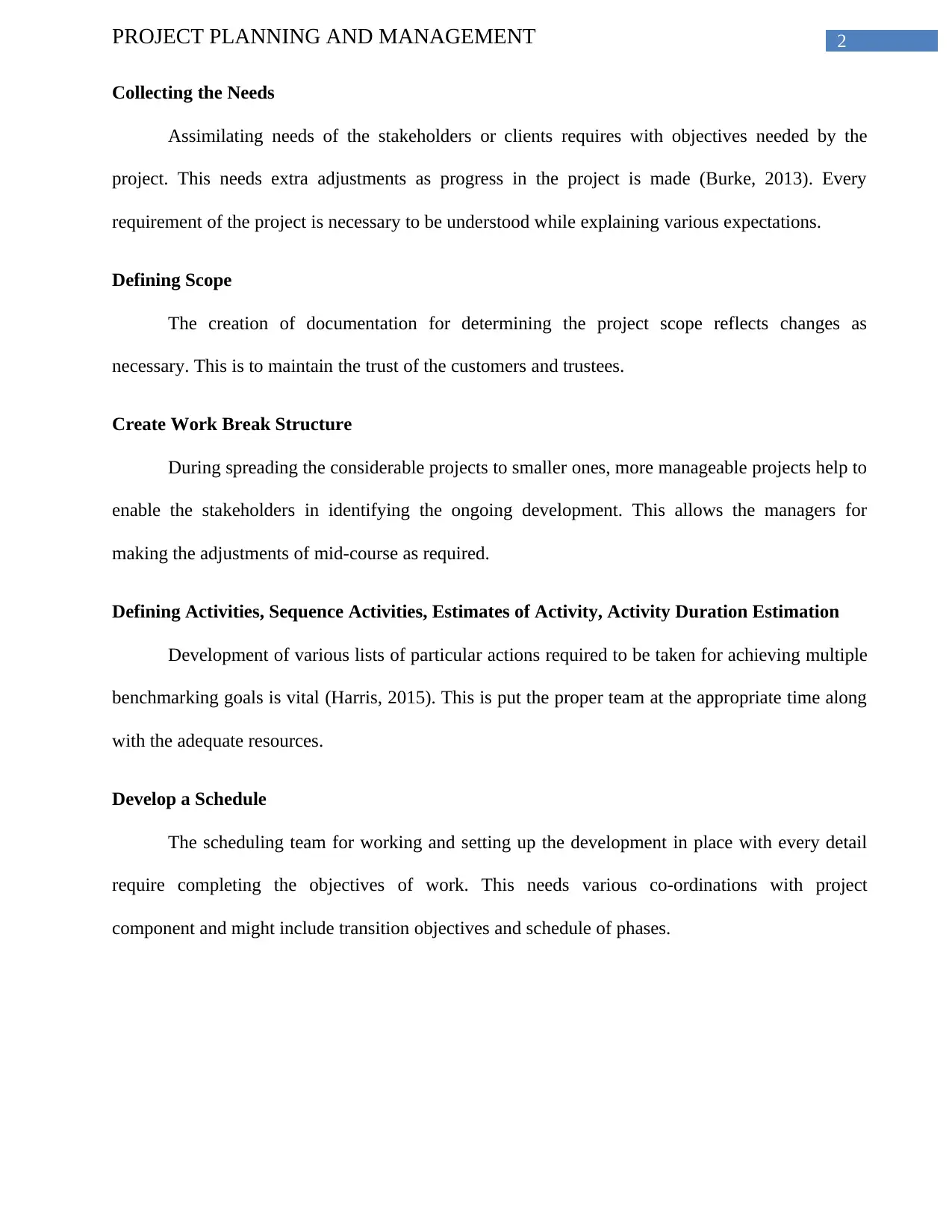
2PROJECT PLANNING AND MANAGEMENT
Collecting the Needs
Assimilating needs of the stakeholders or clients requires with objectives needed by the
project. This needs extra adjustments as progress in the project is made (Burke, 2013). Every
requirement of the project is necessary to be understood while explaining various expectations.
Defining Scope
The creation of documentation for determining the project scope reflects changes as
necessary. This is to maintain the trust of the customers and trustees.
Create Work Break Structure
During spreading the considerable projects to smaller ones, more manageable projects help to
enable the stakeholders in identifying the ongoing development. This allows the managers for
making the adjustments of mid-course as required.
Defining Activities, Sequence Activities, Estimates of Activity, Activity Duration Estimation
Development of various lists of particular actions required to be taken for achieving multiple
benchmarking goals is vital (Harris, 2015). This is put the proper team at the appropriate time along
with the adequate resources.
Develop a Schedule
The scheduling team for working and setting up the development in place with every detail
require completing the objectives of work. This needs various co-ordinations with project
component and might include transition objectives and schedule of phases.
Collecting the Needs
Assimilating needs of the stakeholders or clients requires with objectives needed by the
project. This needs extra adjustments as progress in the project is made (Burke, 2013). Every
requirement of the project is necessary to be understood while explaining various expectations.
Defining Scope
The creation of documentation for determining the project scope reflects changes as
necessary. This is to maintain the trust of the customers and trustees.
Create Work Break Structure
During spreading the considerable projects to smaller ones, more manageable projects help to
enable the stakeholders in identifying the ongoing development. This allows the managers for
making the adjustments of mid-course as required.
Defining Activities, Sequence Activities, Estimates of Activity, Activity Duration Estimation
Development of various lists of particular actions required to be taken for achieving multiple
benchmarking goals is vital (Harris, 2015). This is put the proper team at the appropriate time along
with the adequate resources.
Develop a Schedule
The scheduling team for working and setting up the development in place with every detail
require completing the objectives of work. This needs various co-ordinations with project
component and might include transition objectives and schedule of phases.
⊘ This is a preview!⊘
Do you want full access?
Subscribe today to unlock all pages.

Trusted by 1+ million students worldwide
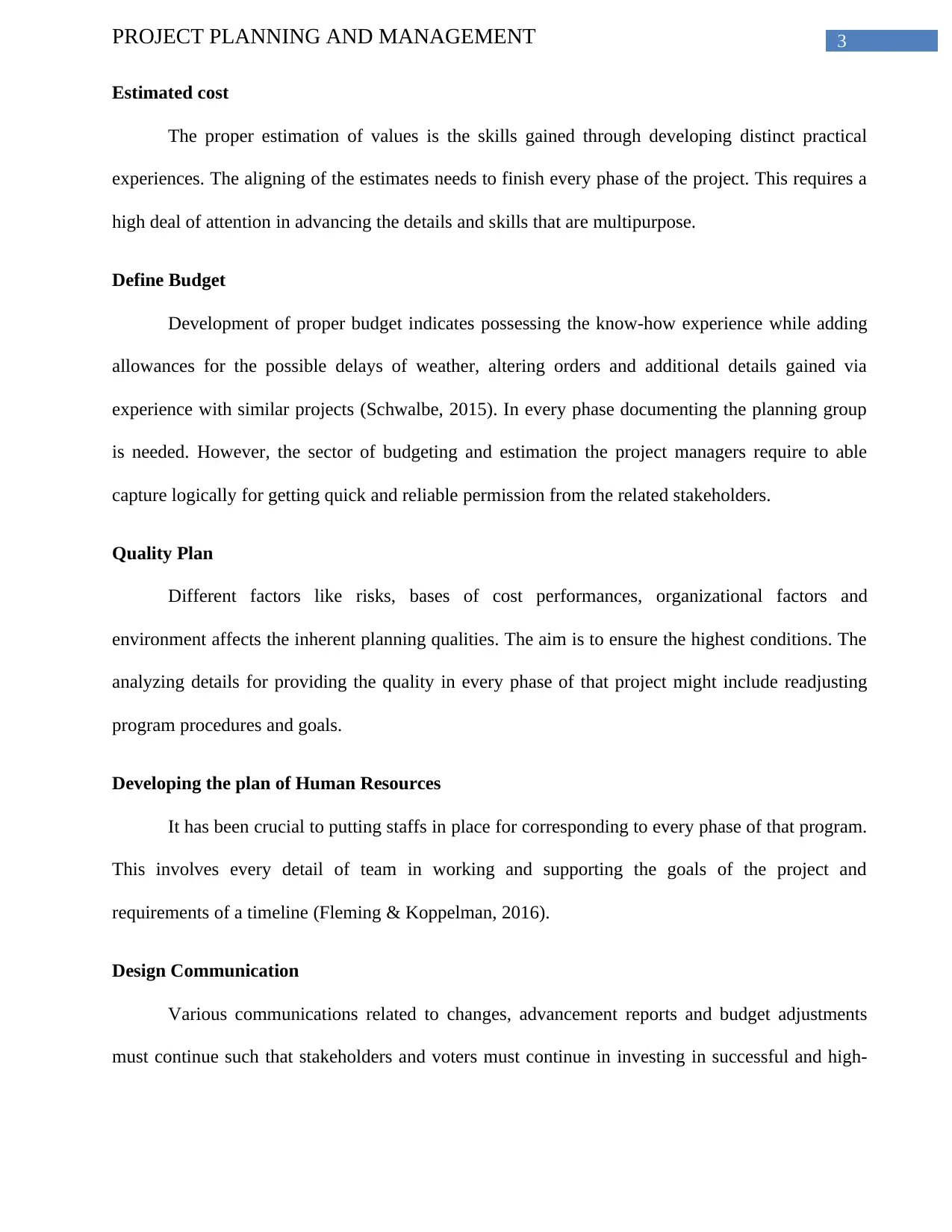
3PROJECT PLANNING AND MANAGEMENT
Estimated cost
The proper estimation of values is the skills gained through developing distinct practical
experiences. The aligning of the estimates needs to finish every phase of the project. This requires a
high deal of attention in advancing the details and skills that are multipurpose.
Define Budget
Development of proper budget indicates possessing the know-how experience while adding
allowances for the possible delays of weather, altering orders and additional details gained via
experience with similar projects (Schwalbe, 2015). In every phase documenting the planning group
is needed. However, the sector of budgeting and estimation the project managers require to able
capture logically for getting quick and reliable permission from the related stakeholders.
Quality Plan
Different factors like risks, bases of cost performances, organizational factors and
environment affects the inherent planning qualities. The aim is to ensure the highest conditions. The
analyzing details for providing the quality in every phase of that project might include readjusting
program procedures and goals.
Developing the plan of Human Resources
It has been crucial to putting staffs in place for corresponding to every phase of that program.
This involves every detail of team in working and supporting the goals of the project and
requirements of a timeline (Fleming & Koppelman, 2016).
Design Communication
Various communications related to changes, advancement reports and budget adjustments
must continue such that stakeholders and voters must continue in investing in successful and high-
Estimated cost
The proper estimation of values is the skills gained through developing distinct practical
experiences. The aligning of the estimates needs to finish every phase of the project. This requires a
high deal of attention in advancing the details and skills that are multipurpose.
Define Budget
Development of proper budget indicates possessing the know-how experience while adding
allowances for the possible delays of weather, altering orders and additional details gained via
experience with similar projects (Schwalbe, 2015). In every phase documenting the planning group
is needed. However, the sector of budgeting and estimation the project managers require to able
capture logically for getting quick and reliable permission from the related stakeholders.
Quality Plan
Different factors like risks, bases of cost performances, organizational factors and
environment affects the inherent planning qualities. The aim is to ensure the highest conditions. The
analyzing details for providing the quality in every phase of that project might include readjusting
program procedures and goals.
Developing the plan of Human Resources
It has been crucial to putting staffs in place for corresponding to every phase of that program.
This involves every detail of team in working and supporting the goals of the project and
requirements of a timeline (Fleming & Koppelman, 2016).
Design Communication
Various communications related to changes, advancement reports and budget adjustments
must continue such that stakeholders and voters must continue in investing in successful and high-
Paraphrase This Document
Need a fresh take? Get an instant paraphrase of this document with our AI Paraphraser
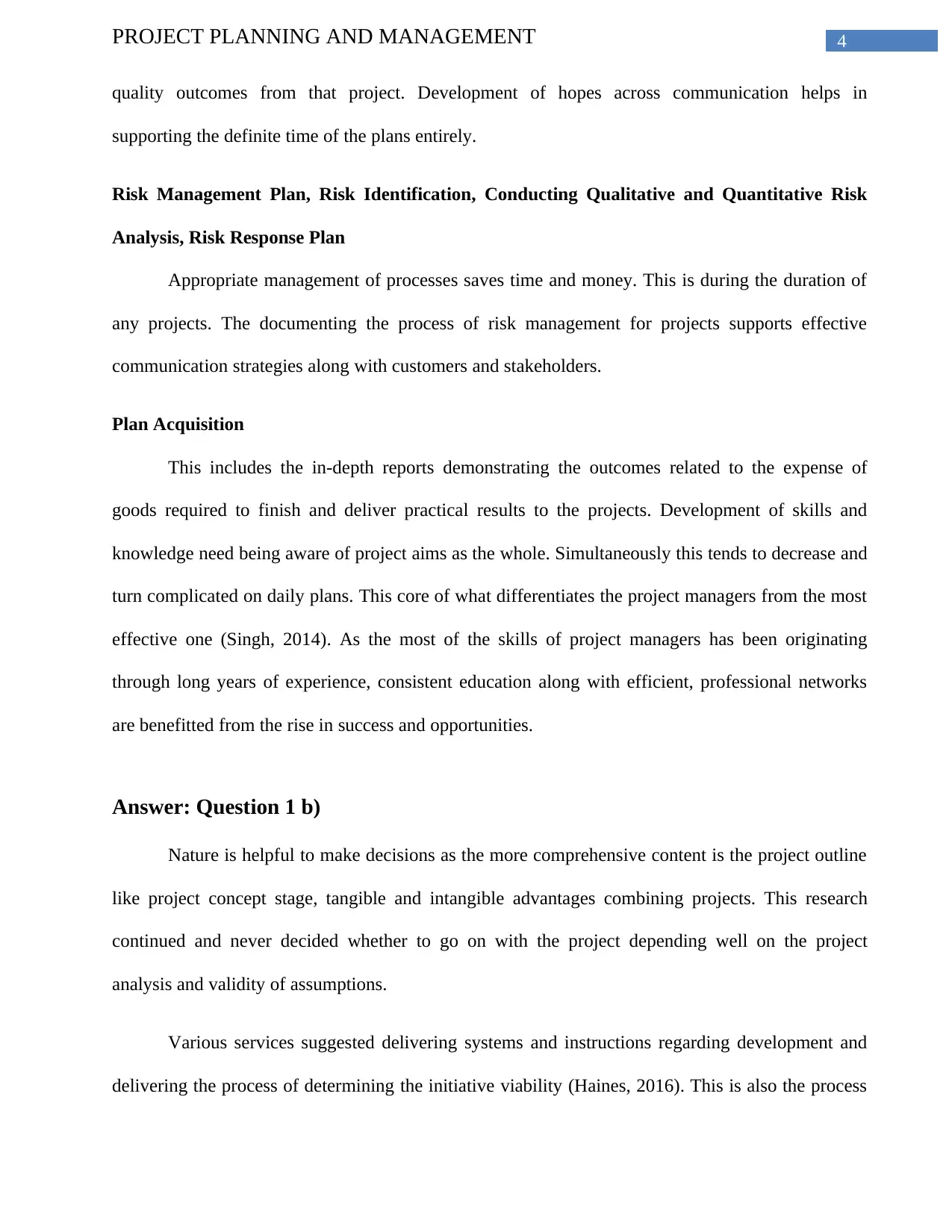
4PROJECT PLANNING AND MANAGEMENT
quality outcomes from that project. Development of hopes across communication helps in
supporting the definite time of the plans entirely.
Risk Management Plan, Risk Identification, Conducting Qualitative and Quantitative Risk
Analysis, Risk Response Plan
Appropriate management of processes saves time and money. This is during the duration of
any projects. The documenting the process of risk management for projects supports effective
communication strategies along with customers and stakeholders.
Plan Acquisition
This includes the in-depth reports demonstrating the outcomes related to the expense of
goods required to finish and deliver practical results to the projects. Development of skills and
knowledge need being aware of project aims as the whole. Simultaneously this tends to decrease and
turn complicated on daily plans. This core of what differentiates the project managers from the most
effective one (Singh, 2014). As the most of the skills of project managers has been originating
through long years of experience, consistent education along with efficient, professional networks
are benefitted from the rise in success and opportunities.
Answer: Question 1 b)
Nature is helpful to make decisions as the more comprehensive content is the project outline
like project concept stage, tangible and intangible advantages combining projects. This research
continued and never decided whether to go on with the project depending well on the project
analysis and validity of assumptions.
Various services suggested delivering systems and instructions regarding development and
delivering the process of determining the initiative viability (Haines, 2016). This is also the process
quality outcomes from that project. Development of hopes across communication helps in
supporting the definite time of the plans entirely.
Risk Management Plan, Risk Identification, Conducting Qualitative and Quantitative Risk
Analysis, Risk Response Plan
Appropriate management of processes saves time and money. This is during the duration of
any projects. The documenting the process of risk management for projects supports effective
communication strategies along with customers and stakeholders.
Plan Acquisition
This includes the in-depth reports demonstrating the outcomes related to the expense of
goods required to finish and deliver practical results to the projects. Development of skills and
knowledge need being aware of project aims as the whole. Simultaneously this tends to decrease and
turn complicated on daily plans. This core of what differentiates the project managers from the most
effective one (Singh, 2014). As the most of the skills of project managers has been originating
through long years of experience, consistent education along with efficient, professional networks
are benefitted from the rise in success and opportunities.
Answer: Question 1 b)
Nature is helpful to make decisions as the more comprehensive content is the project outline
like project concept stage, tangible and intangible advantages combining projects. This research
continued and never decided whether to go on with the project depending well on the project
analysis and validity of assumptions.
Various services suggested delivering systems and instructions regarding development and
delivering the process of determining the initiative viability (Haines, 2016). This is also the process
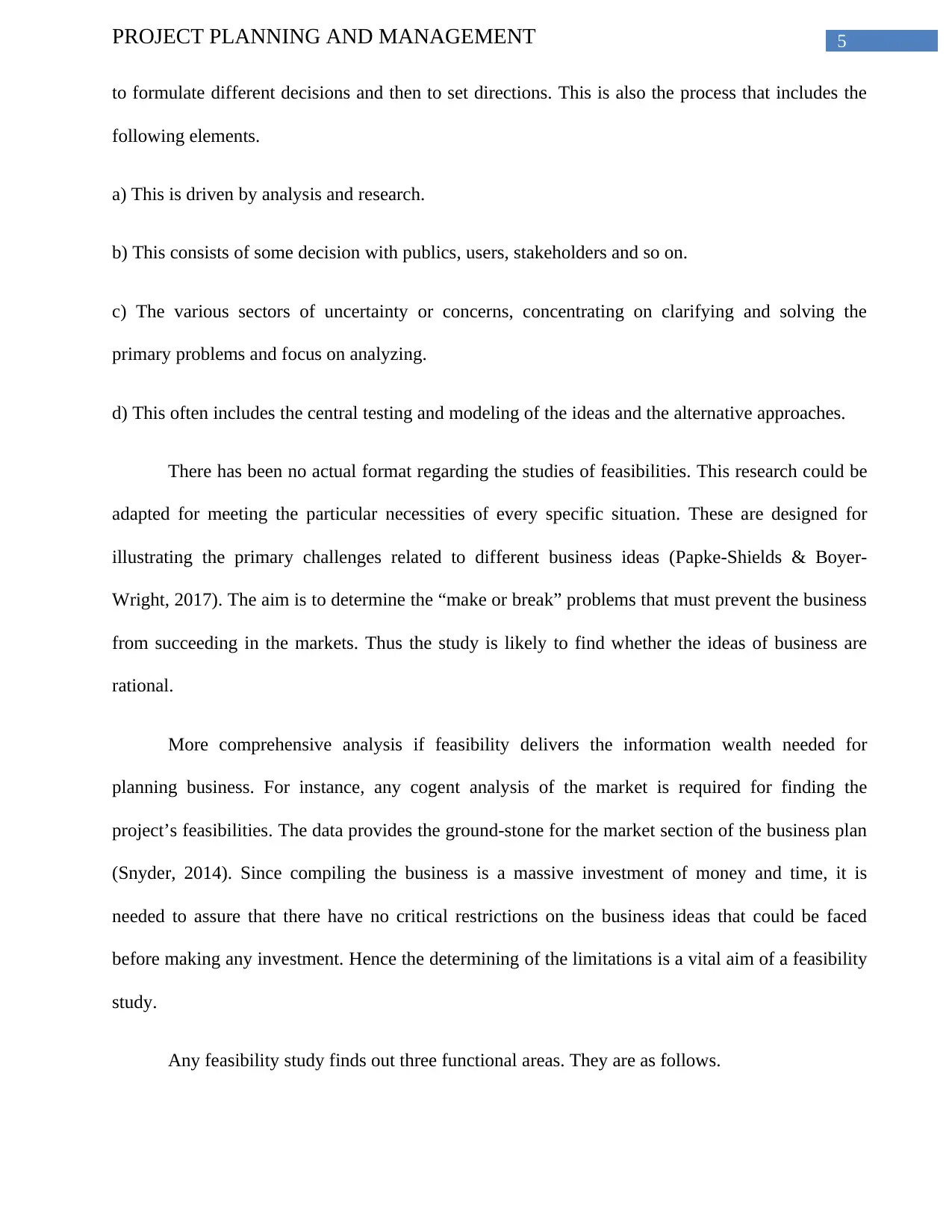
5PROJECT PLANNING AND MANAGEMENT
to formulate different decisions and then to set directions. This is also the process that includes the
following elements.
a) This is driven by analysis and research.
b) This consists of some decision with publics, users, stakeholders and so on.
c) The various sectors of uncertainty or concerns, concentrating on clarifying and solving the
primary problems and focus on analyzing.
d) This often includes the central testing and modeling of the ideas and the alternative approaches.
There has been no actual format regarding the studies of feasibilities. This research could be
adapted for meeting the particular necessities of every specific situation. These are designed for
illustrating the primary challenges related to different business ideas (Papke-Shields & Boyer-
Wright, 2017). The aim is to determine the “make or break” problems that must prevent the business
from succeeding in the markets. Thus the study is likely to find whether the ideas of business are
rational.
More comprehensive analysis if feasibility delivers the information wealth needed for
planning business. For instance, any cogent analysis of the market is required for finding the
project’s feasibilities. The data provides the ground-stone for the market section of the business plan
(Snyder, 2014). Since compiling the business is a massive investment of money and time, it is
needed to assure that there have no critical restrictions on the business ideas that could be faced
before making any investment. Hence the determining of the limitations is a vital aim of a feasibility
study.
Any feasibility study finds out three functional areas. They are as follows.
to formulate different decisions and then to set directions. This is also the process that includes the
following elements.
a) This is driven by analysis and research.
b) This consists of some decision with publics, users, stakeholders and so on.
c) The various sectors of uncertainty or concerns, concentrating on clarifying and solving the
primary problems and focus on analyzing.
d) This often includes the central testing and modeling of the ideas and the alternative approaches.
There has been no actual format regarding the studies of feasibilities. This research could be
adapted for meeting the particular necessities of every specific situation. These are designed for
illustrating the primary challenges related to different business ideas (Papke-Shields & Boyer-
Wright, 2017). The aim is to determine the “make or break” problems that must prevent the business
from succeeding in the markets. Thus the study is likely to find whether the ideas of business are
rational.
More comprehensive analysis if feasibility delivers the information wealth needed for
planning business. For instance, any cogent analysis of the market is required for finding the
project’s feasibilities. The data provides the ground-stone for the market section of the business plan
(Snyder, 2014). Since compiling the business is a massive investment of money and time, it is
needed to assure that there have no critical restrictions on the business ideas that could be faced
before making any investment. Hence the determining of the limitations is a vital aim of a feasibility
study.
Any feasibility study finds out three functional areas. They are as follows.
⊘ This is a preview!⊘
Do you want full access?
Subscribe today to unlock all pages.

Trusted by 1+ million students worldwide
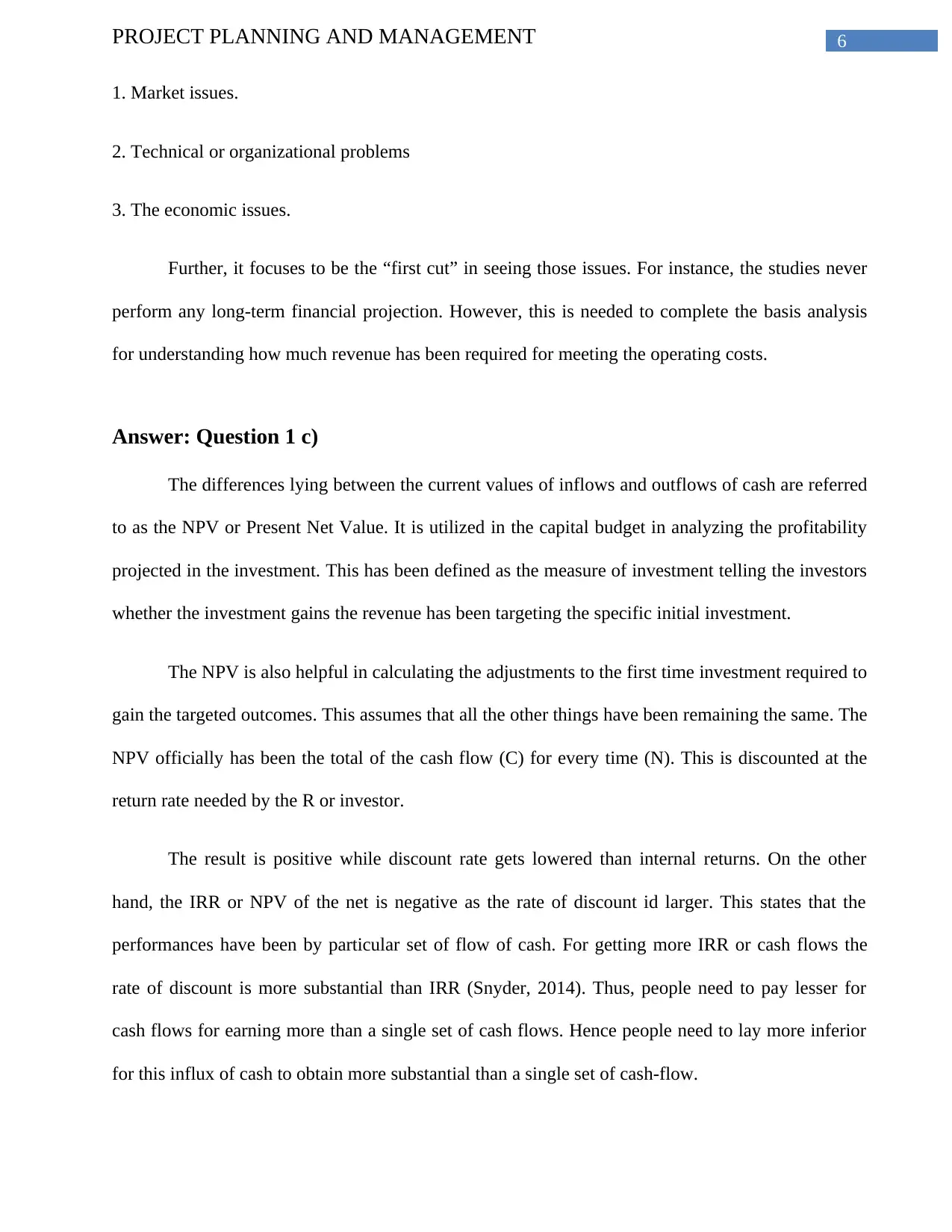
6PROJECT PLANNING AND MANAGEMENT
1. Market issues.
2. Technical or organizational problems
3. The economic issues.
Further, it focuses to be the “first cut” in seeing those issues. For instance, the studies never
perform any long-term financial projection. However, this is needed to complete the basis analysis
for understanding how much revenue has been required for meeting the operating costs.
Answer: Question 1 c)
The differences lying between the current values of inflows and outflows of cash are referred
to as the NPV or Present Net Value. It is utilized in the capital budget in analyzing the profitability
projected in the investment. This has been defined as the measure of investment telling the investors
whether the investment gains the revenue has been targeting the specific initial investment.
The NPV is also helpful in calculating the adjustments to the first time investment required to
gain the targeted outcomes. This assumes that all the other things have been remaining the same. The
NPV officially has been the total of the cash flow (C) for every time (N). This is discounted at the
return rate needed by the R or investor.
The result is positive while discount rate gets lowered than internal returns. On the other
hand, the IRR or NPV of the net is negative as the rate of discount id larger. This states that the
performances have been by particular set of flow of cash. For getting more IRR or cash flows the
rate of discount is more substantial than IRR (Snyder, 2014). Thus, people need to pay lesser for
cash flows for earning more than a single set of cash flows. Hence people need to lay more inferior
for this influx of cash to obtain more substantial than a single set of cash-flow.
1. Market issues.
2. Technical or organizational problems
3. The economic issues.
Further, it focuses to be the “first cut” in seeing those issues. For instance, the studies never
perform any long-term financial projection. However, this is needed to complete the basis analysis
for understanding how much revenue has been required for meeting the operating costs.
Answer: Question 1 c)
The differences lying between the current values of inflows and outflows of cash are referred
to as the NPV or Present Net Value. It is utilized in the capital budget in analyzing the profitability
projected in the investment. This has been defined as the measure of investment telling the investors
whether the investment gains the revenue has been targeting the specific initial investment.
The NPV is also helpful in calculating the adjustments to the first time investment required to
gain the targeted outcomes. This assumes that all the other things have been remaining the same. The
NPV officially has been the total of the cash flow (C) for every time (N). This is discounted at the
return rate needed by the R or investor.
The result is positive while discount rate gets lowered than internal returns. On the other
hand, the IRR or NPV of the net is negative as the rate of discount id larger. This states that the
performances have been by particular set of flow of cash. For getting more IRR or cash flows the
rate of discount is more substantial than IRR (Snyder, 2014). Thus, people need to pay lesser for
cash flows for earning more than a single set of cash flows. Hence people need to lay more inferior
for this influx of cash to obtain more substantial than a single set of cash-flow.
Paraphrase This Document
Need a fresh take? Get an instant paraphrase of this document with our AI Paraphraser
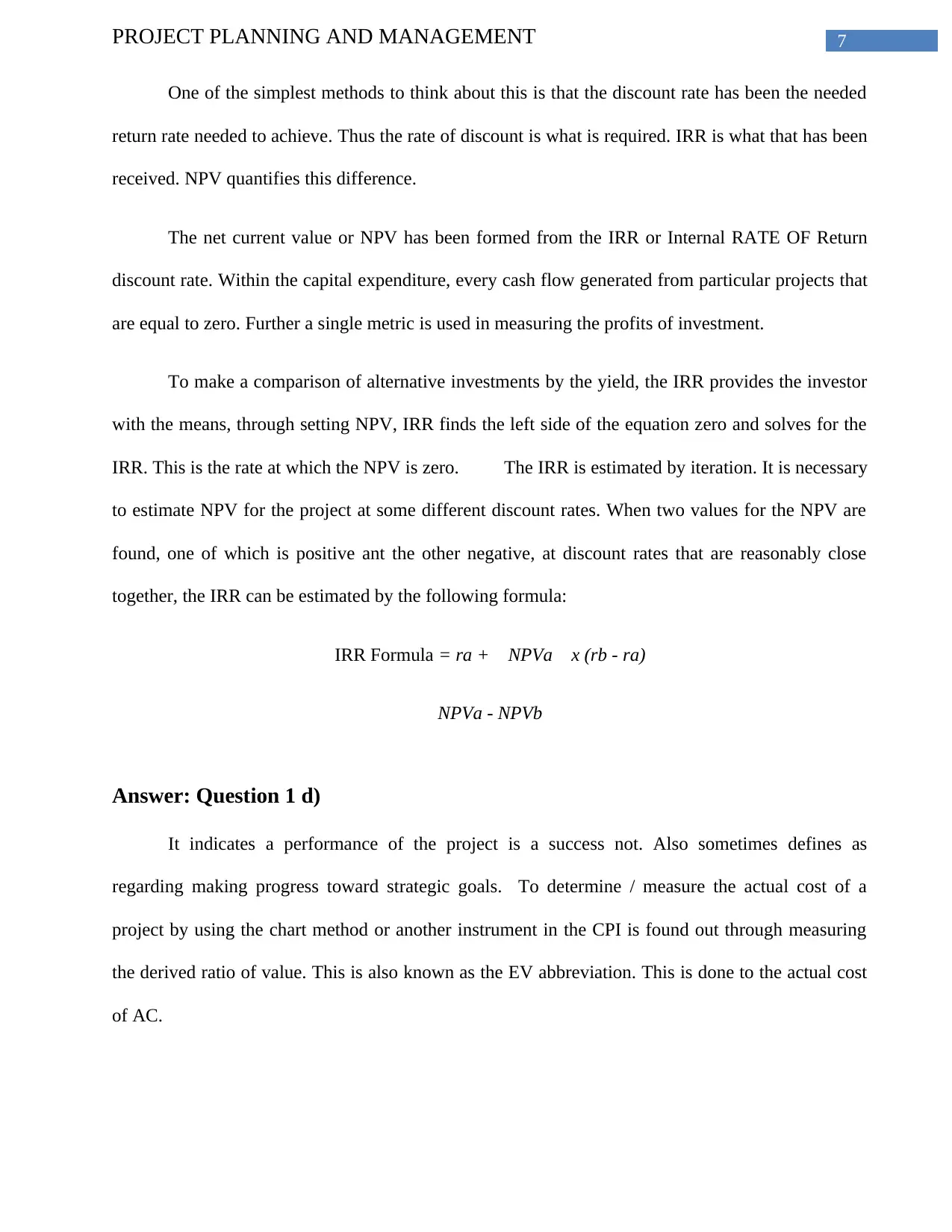
7PROJECT PLANNING AND MANAGEMENT
One of the simplest methods to think about this is that the discount rate has been the needed
return rate needed to achieve. Thus the rate of discount is what is required. IRR is what that has been
received. NPV quantifies this difference.
The net current value or NPV has been formed from the IRR or Internal RATE OF Return
discount rate. Within the capital expenditure, every cash flow generated from particular projects that
are equal to zero. Further a single metric is used in measuring the profits of investment.
To make a comparison of alternative investments by the yield, the IRR provides the investor
with the means, through setting NPV, IRR finds the left side of the equation zero and solves for the
IRR. This is the rate at which the NPV is zero. The IRR is estimated by iteration. It is necessary
to estimate NPV for the project at some different discount rates. When two values for the NPV are
found, one of which is positive ant the other negative, at discount rates that are reasonably close
together, the IRR can be estimated by the following formula:
IRR Formula = ra + NPVa x (rb - ra)
NPVa - NPVb
Answer: Question 1 d)
It indicates a performance of the project is a success not. Also sometimes defines as
regarding making progress toward strategic goals. To determine / measure the actual cost of a
project by using the chart method or another instrument in the CPI is found out through measuring
the derived ratio of value. This is also known as the EV abbreviation. This is done to the actual cost
of AC.
One of the simplest methods to think about this is that the discount rate has been the needed
return rate needed to achieve. Thus the rate of discount is what is required. IRR is what that has been
received. NPV quantifies this difference.
The net current value or NPV has been formed from the IRR or Internal RATE OF Return
discount rate. Within the capital expenditure, every cash flow generated from particular projects that
are equal to zero. Further a single metric is used in measuring the profits of investment.
To make a comparison of alternative investments by the yield, the IRR provides the investor
with the means, through setting NPV, IRR finds the left side of the equation zero and solves for the
IRR. This is the rate at which the NPV is zero. The IRR is estimated by iteration. It is necessary
to estimate NPV for the project at some different discount rates. When two values for the NPV are
found, one of which is positive ant the other negative, at discount rates that are reasonably close
together, the IRR can be estimated by the following formula:
IRR Formula = ra + NPVa x (rb - ra)
NPVa - NPVb
Answer: Question 1 d)
It indicates a performance of the project is a success not. Also sometimes defines as
regarding making progress toward strategic goals. To determine / measure the actual cost of a
project by using the chart method or another instrument in the CPI is found out through measuring
the derived ratio of value. This is also known as the EV abbreviation. This is done to the actual cost
of AC.
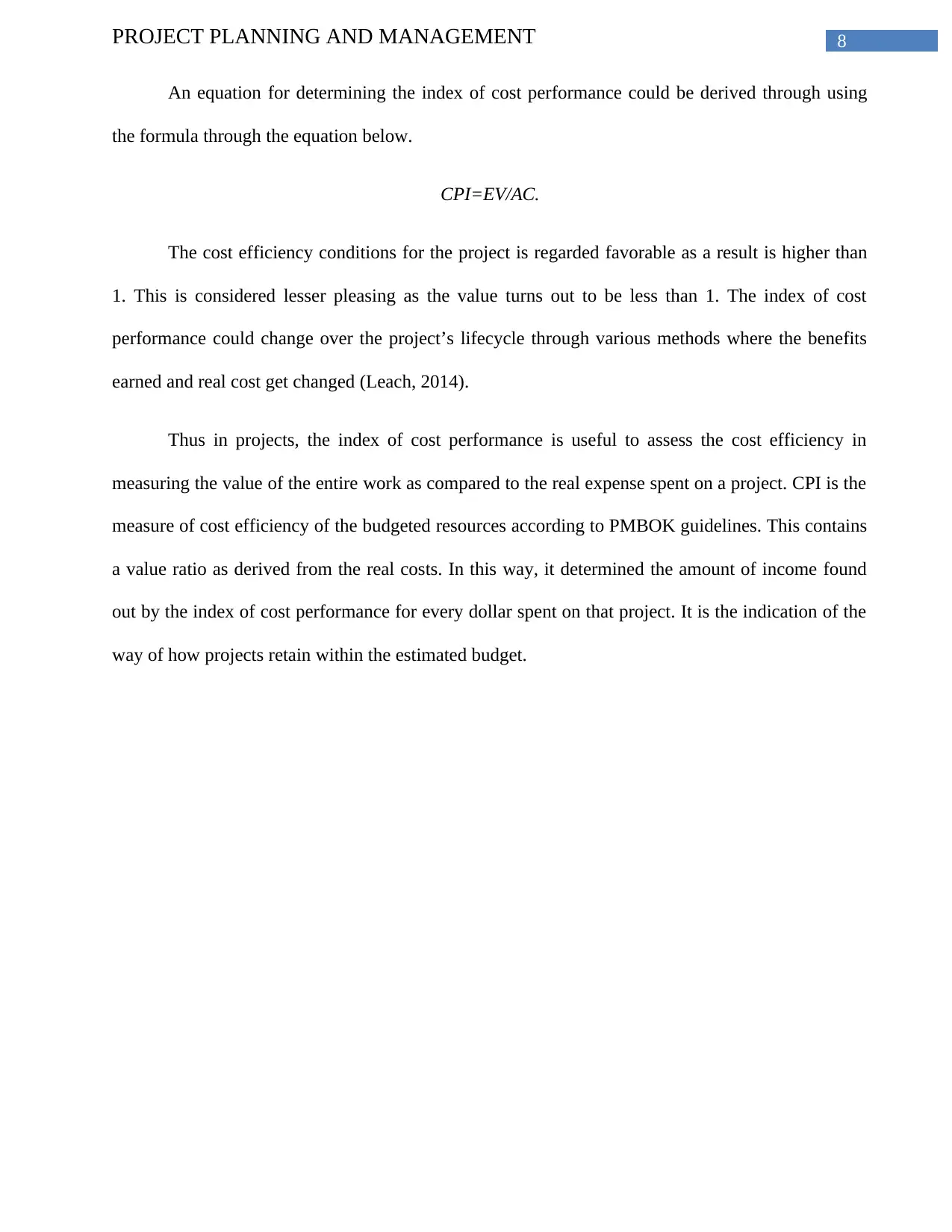
8PROJECT PLANNING AND MANAGEMENT
An equation for determining the index of cost performance could be derived through using
the formula through the equation below.
CPI=EV/AC.
The cost efficiency conditions for the project is regarded favorable as a result is higher than
1. This is considered lesser pleasing as the value turns out to be less than 1. The index of cost
performance could change over the project’s lifecycle through various methods where the benefits
earned and real cost get changed (Leach, 2014).
Thus in projects, the index of cost performance is useful to assess the cost efficiency in
measuring the value of the entire work as compared to the real expense spent on a project. CPI is the
measure of cost efficiency of the budgeted resources according to PMBOK guidelines. This contains
a value ratio as derived from the real costs. In this way, it determined the amount of income found
out by the index of cost performance for every dollar spent on that project. It is the indication of the
way of how projects retain within the estimated budget.
An equation for determining the index of cost performance could be derived through using
the formula through the equation below.
CPI=EV/AC.
The cost efficiency conditions for the project is regarded favorable as a result is higher than
1. This is considered lesser pleasing as the value turns out to be less than 1. The index of cost
performance could change over the project’s lifecycle through various methods where the benefits
earned and real cost get changed (Leach, 2014).
Thus in projects, the index of cost performance is useful to assess the cost efficiency in
measuring the value of the entire work as compared to the real expense spent on a project. CPI is the
measure of cost efficiency of the budgeted resources according to PMBOK guidelines. This contains
a value ratio as derived from the real costs. In this way, it determined the amount of income found
out by the index of cost performance for every dollar spent on that project. It is the indication of the
way of how projects retain within the estimated budget.
⊘ This is a preview!⊘
Do you want full access?
Subscribe today to unlock all pages.

Trusted by 1+ million students worldwide
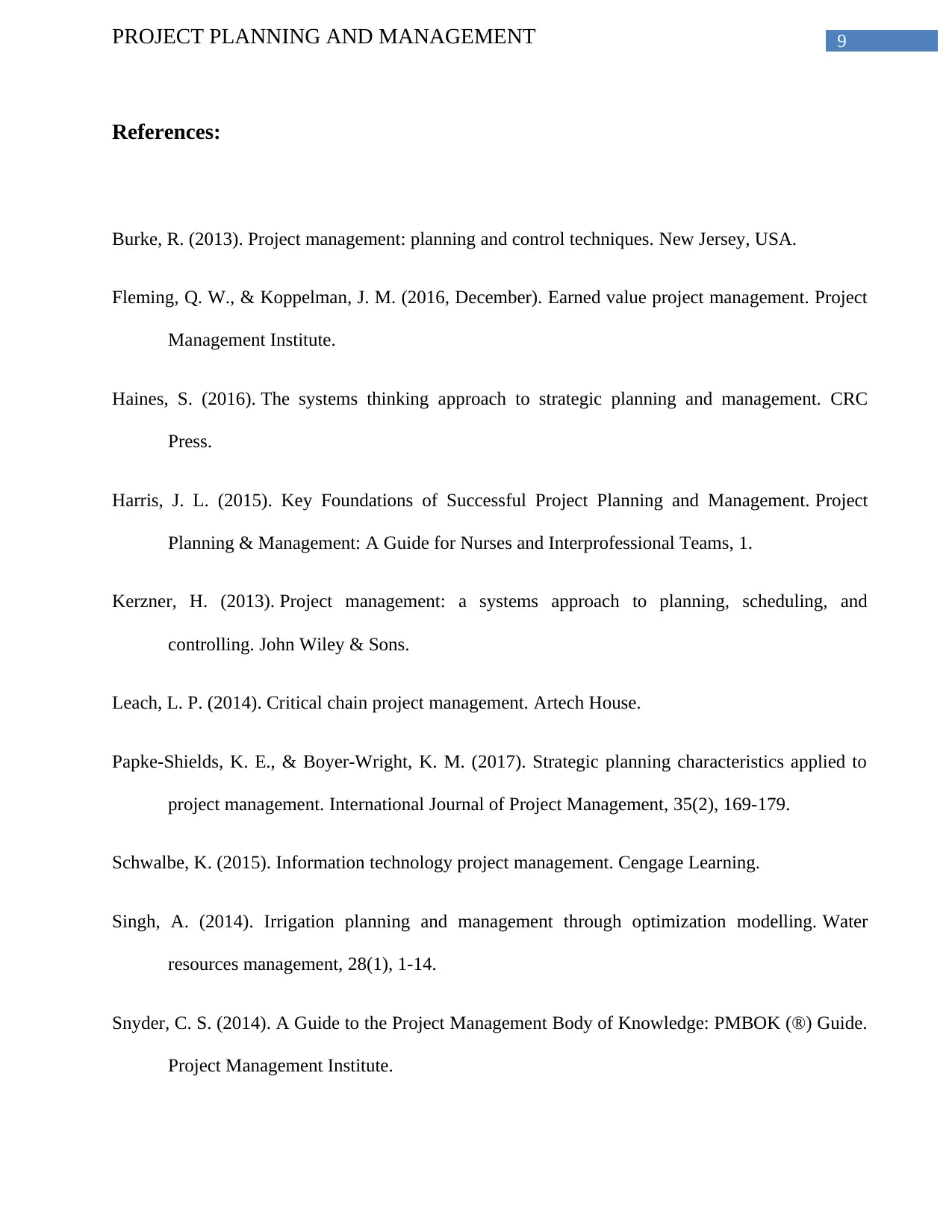
9PROJECT PLANNING AND MANAGEMENT
References:
Burke, R. (2013). Project management: planning and control techniques. New Jersey, USA.
Fleming, Q. W., & Koppelman, J. M. (2016, December). Earned value project management. Project
Management Institute.
Haines, S. (2016). The systems thinking approach to strategic planning and management. CRC
Press.
Harris, J. L. (2015). Key Foundations of Successful Project Planning and Management. Project
Planning & Management: A Guide for Nurses and Interprofessional Teams, 1.
Kerzner, H. (2013). Project management: a systems approach to planning, scheduling, and
controlling. John Wiley & Sons.
Leach, L. P. (2014). Critical chain project management. Artech House.
Papke-Shields, K. E., & Boyer-Wright, K. M. (2017). Strategic planning characteristics applied to
project management. International Journal of Project Management, 35(2), 169-179.
Schwalbe, K. (2015). Information technology project management. Cengage Learning.
Singh, A. (2014). Irrigation planning and management through optimization modelling. Water
resources management, 28(1), 1-14.
Snyder, C. S. (2014). A Guide to the Project Management Body of Knowledge: PMBOK (®) Guide.
Project Management Institute.
References:
Burke, R. (2013). Project management: planning and control techniques. New Jersey, USA.
Fleming, Q. W., & Koppelman, J. M. (2016, December). Earned value project management. Project
Management Institute.
Haines, S. (2016). The systems thinking approach to strategic planning and management. CRC
Press.
Harris, J. L. (2015). Key Foundations of Successful Project Planning and Management. Project
Planning & Management: A Guide for Nurses and Interprofessional Teams, 1.
Kerzner, H. (2013). Project management: a systems approach to planning, scheduling, and
controlling. John Wiley & Sons.
Leach, L. P. (2014). Critical chain project management. Artech House.
Papke-Shields, K. E., & Boyer-Wright, K. M. (2017). Strategic planning characteristics applied to
project management. International Journal of Project Management, 35(2), 169-179.
Schwalbe, K. (2015). Information technology project management. Cengage Learning.
Singh, A. (2014). Irrigation planning and management through optimization modelling. Water
resources management, 28(1), 1-14.
Snyder, C. S. (2014). A Guide to the Project Management Body of Knowledge: PMBOK (®) Guide.
Project Management Institute.
Paraphrase This Document
Need a fresh take? Get an instant paraphrase of this document with our AI Paraphraser

10PROJECT PLANNING AND MANAGEMENT

11PROJECT PLANNING AND MANAGEMENT
⊘ This is a preview!⊘
Do you want full access?
Subscribe today to unlock all pages.

Trusted by 1+ million students worldwide
1 out of 12
Related Documents
Your All-in-One AI-Powered Toolkit for Academic Success.
+13062052269
info@desklib.com
Available 24*7 on WhatsApp / Email
![[object Object]](/_next/static/media/star-bottom.7253800d.svg)
Unlock your academic potential
Copyright © 2020–2025 A2Z Services. All Rights Reserved. Developed and managed by ZUCOL.




